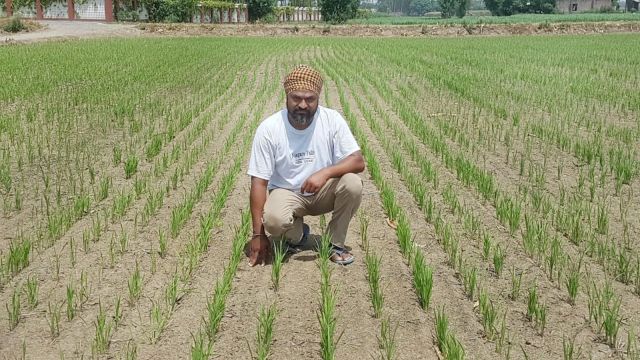Acreage under DSR up 16%, Punjab farmers signal slow and steady shift
Officials say that extensive awareness campaigns, hands-on training for farmers, and on-ground support for weed and nutrient management are essential to build confidence in the DSR technique.
 The government had set an ambitious target of bringing 5 lakh acres under DSR this year. (Express)
The government had set an ambitious target of bringing 5 lakh acres under DSR this year. (Express)Punjab has recorded a 16% jump in the adoption of direct seeding of rice (DSR) this Kharif season compared to last year, signalling a slow but steady shift in the state’s efforts to conserve water in paddy cultivation. As per the data from the Punjab Agriculture Department, around 2.94 lakh acres have been brought under DSR this year, up from 2.53 lakh acres in 2024.
The government had set an ambitious target of bringing 5 lakh acres under DSR this year. The area covered so far accounts for just 3.72% of the total rice cultivation in Punjab — including both paddy and Basmati varieties,
Among the districts, Fazilka leads the way with 1.03 lakh acres under DSR, followed by Sri Muktsar Sahib (98,535 acres). Other districts with notable coverage include Firozepur (18,056 acres), Bathinda (14,382 acres), Amritsar (7906 acres), Mansa (7,281 acres), Faridkot (5,728 acres), Barnala (5,379 acres), Ludhiana (5,564 acres), Patiala (4,552 acres), Tarn Taran (3919 acres), Gurdaspur (3,263 acres), Moga (3,053 acres) and Fatehgarh Sahib (2,486 acres). The lowest adoption was recorded in Ropar, with just 219 acres under DSR.
A decade-long journey with ups and downs
The DSR technique — formally recommended by the agriculture department in 2010 — was initially adopted by only a few hundred farmers. In 2012, farmers adopted DSR in around 22,000 acres. The following years saw a surge: 96,083 acres in 2013, 2.84 lakh acres in 2014, and 4.07 lakh acres in 2015.
However, this growth was not sustained. Between 2016 and 2019, the area under DSR sharply declined due to technical challenges. Farmers unfamiliar with soil suitability, weed management, and nutrient requirements reported significant yield losses, leading to a crisis of confidence in the method.
The Covid-19 pandemic in 2020 and the resulting labour shortages once again brought DSR into the spotlight, as farmers struggled to find labourers for traditional paddy transplantation. That year, DSR adoption jumped to over 5 lakh hectares (12.35 lakh acres), accounting for nearly 18% of the total paddy area. It further grew in 2021 to 5.62 lakh hectares (13.89 lakh acres), driven by the second wave of the pandemic.
However, as normalcy returned and migrant labourers became available again, DSR lost its momentum. The area under it dipped sharply to 1.71 lakh acres in 2022, marginally improving to 1.73 lakh acres in 2023, before reaching 2.53 lakh acres in 2024.
Why DSR Matters
Unlike the traditional puddled transplanting method — where seedlings are grown in nurseries and then transplanted into flooded fields — DSR involves sowing seeds directly into moist soil using a specialised machine. The first irrigation is given only after 21 days, compared to continuous flooding for 4–5 weeks in traditional methods. As a result, DSR saves 15–20% water per acre, making it a potentially critical tool for Punjab, a state grappling with depleting groundwater reserves.
Despite its benefits, adoption remains limited. According to agriculture officials, many farmers still prefer the traditional method, partly due to lack of awareness, technical support, and fear of yield losses. However, those who have consistently used DSR in suitable soils report positive outcomes and continue with the technique.
“DSR is beneficial where soil conditions and irrigation schedules are managed properly,” said Narinder Singh Benipal, Joint Director, Agriculture. “We have seen a 16.12% increase in DSR acreage this year, which is a good sign.”
The Way Forward
Officials say that extensive awareness campaigns, hands-on training for farmers, and on-ground support for weed and nutrient management are essential to build confidence in the DSR technique.
While the gains this year are encouraging, Punjab’s long-term sustainability in rice cultivation hinges on scaling up water-saving methods like DSR — especially as climate change and water scarcity become more pressing. The challenge is not just technical, but cultural: convincing farmers to shift from age-old practices to this, but ultimately, better yields.












